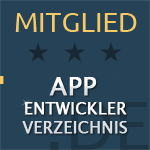
Insight

Insight

Insight
Using SOLID Principles in Flutter


Julian Giesen
·
·
Monday, April 15, 2024


Julian Giesen
SOLID principles are employed to write efficient and functional code and ensure that it is maintainable in the long term.
Why are the SOLID principles important?
The SOLID principles are fundamental design principles that help to write high-quality code. They serve as guidelines to make code easier to understand, maintain, and extend. By applying these principles, the code becomes more flexible, less prone to errors, and easier to test.
Importance of the SOLID principles for Flutter developers
For Flutter developers, the SOLID principles are particularly important, as Flutter is a framework designed for rapid development and maintenance of cross-platform apps. By understanding and applying these principles, we can ensure that our Flutter apps remain scalable, maintainable, and extensible while also providing high code quality and user experience.
In this article, we will take a closer look at each of the five SOLID principles and explore how they can be applied in Flutter app development to create robust and high-quality applications.
SOLID Principles and Flutter
The SOLID principles are fundamental design principles introduced by Robert C. Martin to promote the development of flexible, maintainable, and extensible software applications. These principles form the backbone of a clean code architecture for app development in Flutter as well as for other technologies.
Single Responsibility Principle (SRP)
The Single Responsibility Principle is a fundamental design principle that states that a class should have only one responsibility. In other words, a class should be responsible for only one specific task or function. Applying this principle makes the code clearer, easier to understand, and maintain.
In Flutter, applying the SRP means that each class or widget should be responsible for a specific task only. For example, a widget should only be responsible for rendering a specific UI component, without also handling data processing or user interactions.
By limiting each class to a single responsibility, we can improve the maintainability of our Flutter apps. When a class is responsible for only one specific task, it is easier to make changes or fix bugs, as we know exactly where to look.
Another advantage of applying the SRP in Flutter is that it promotes code reusability. If a class has clearly defined responsibilities, it can be easily reused in other parts of the app without needing additional code.
By strictly adhering to the SRP, we can create highly modular, maintainable, and scalable apps that meet our users' needs.
In a chat app project, applying the SRP could mean creating separate classes for data processing, rendering the chat interface, and handling user interactions. Here’s a simple example:
class ChatDataProvider {
// Data processing methods
}
class ChatScreen extends StatelessWidget {
// Methods for rendering the UI
}
class ChatController {
// Methods for handling user interactions
}Open/Closed Principle (OCP)
The Open/Closed Principle is a design principle that states that software entities like classes, modules, or functions should be open for extensions but closed for modifications. In other words, a software entity should be designed so that new functionalities can be added without changing the existing code.
In Flutter, applying the OCP means that we should design our app components in such a way that they are open for future changes and extensions without needing to modify the existing code. This is often achieved through the use of abstractions and interfaces that allow for new functionalities to be added by creating new implementations derived from the existing interfaces.
A good example of applying the OCP in Flutter is using the "freezed" package to define data models. With "freezed", we can define data classes that are open for extensions, as we can add new fields or methods without changing the existing code. At the same time, these classes are closed for modifications since the data classes are immutable and their fields cannot be changed after initialization.
By applying the OCP in Flutter, we can build a flexible and extensible codebase that allows us to add new features and continuously develop the app without affecting the existing code. This helps improve the maintainability and scalability of our Flutter apps and enhances development efficiency.
To demonstrate the OCP, we could create a widget that displays different types of messages. Instead of directly modifying the widget when a new message type is added, we can extend the widget and create a new class for the new message type:
abstract class Message {
String get content;
}
class TextMessage implements Message {
// Implementation for text messages
}
class ImageMessage implements Message {
// Implementation for picture messages
}
class MessageWidget extends StatelessWidget {
final Message message;
MessageWidget(this.message);
@override
Widget build(BuildContext context) {
if (message is TextMessage) {
return Text(message.content);
} else if (message is ImageMessage) {
return Image.network(message.content);
}
// Additional message types can be added here
}
}Liskov Substitution Principle (LSP)
The Liskov Substitution Principle is a design principle that states that objects of a derived class should be used in the same way as objects of their base class without altering the program. In other words, an instance of a derived class should integrate seamlessly into the code without the need to alter program logic.
In Flutter, applying the LSP means that subtypes should be designed in a way that they can be replaced by their base types without issues. This allows for high interoperability between different classes and widgets in our Flutter app.
An example of applying the LSP in Flutter is using polymorphism to swap different types of widgets. For example, if we define an abstract base class for a specific type of UI element, we can easily create various subclasses that represent specific implementations of that UI element. These subclasses can then be used in place of the base class without needing to adjust the rest of the code.
By applying the LSP in Flutter, we can make our codebase more flexible and promote reusability of code. This helps improve the scalability and maintainability of our Flutter apps, as we can add new functionalities or change existing ones without affecting the existing code.
Through consistent application of the LSP, we can ensure that our Flutter apps are robust and extensible, meeting the ever-changing needs of our users.
The LSP could be applied in a project by ensuring that subtypes can be seamlessly replaced by their base types. Here’s a short code example:
abstract class Animal {
void makeSound();
}
class Dog implements Animal {
@override
void makeSound() {
print('Woof!');
}
}
class Cat implements Animal {
@override
void makeSound() {
print('Meow!');
}
}Interface Segregation Principle (ISP)
The Interface Segregation Principle is a design principle that states that a class should not depend on methods it does not use. In other words, a class should only depend on the methods it actually needs and not on unnecessary methods of other classes.
In Flutter, applying the ISP means that we should split interfaces to avoid dependencies and increase flexibility. This is often achieved by defining specific interfaces that only include the methods needed by the classes that implement them.
An example of applying the ISP in Flutter is using mixins to integrate specific behaviors into widgets. Instead of defining a large interface that contains many methods, we can create specific mixins that only include the methods necessary for the behavior in question. This allows widgets to implement only the functions they need without unnecessary dependencies.
By applying the ISP in Flutter, we can reduce the dependencies between different parts of our app and increase flexibility. This enables us to develop and test individual components independently, which improves the maintainability and scalability of our Flutter apps.
By splitting interfaces according to the ISP, we can ensure that our Flutter apps are modular and well-structured. This facilitates the development of new features and the maintenance of existing ones, as we become less prone to unexpected side effects or unwanted dependencies.
The ISP could be applied by splitting interfaces to avoid dependencies. Here’s an example:
abstract class Printer {
void print();
}
abstract class Scanner {
void scan();
}
class MultiFunctionDevice implements Printer, Scanner {
@override
void print() {
// Implementation for printing
}
@override
void scan() {
// Implementation for scanning
}
}Dependency Inversion Principle (DIP)
The Dependency Inversion Principle is a design principle that states that dependencies should be based on abstract types and not on concrete implementations. In other words, high-level modules should not depend on low-level modules, but both should depend on abstract interfaces. This promotes loose coupling and increases the flexibility and testability of the code.
In Flutter, applying the DIP means that we should invert dependencies to make our app more flexible and testable. Instead of directly accessing concrete implementations, high-level modules should depend on abstract interfaces or classes. This allows us to swap different implementations without needing to change the rest of the code.
An example of applying the DIP in Flutter is using dependency injection (DI) to provide dependencies. Instead of creating or instantiating dependencies within a class, we can inject them via DI. This allows us to exchange different implementations of the dependencies simply by changing the corresponding DI configurations without affecting the remaining code.
By applying the DIP, we can improve the testability of our Flutter apps, as we can more easily use mock objects for testing. It also makes our apps more flexible since we can add new features or change existing ones more easily without causing far-reaching impacts on the rest of the code.
Overall, applying the Dependency Inversion Principle helps ensure that our Flutter apps are better structured, more flexible, and easier to maintain. By inverting dependencies and relying on abstract interfaces, we can develop high-quality and scalable apps that meet the needs of our users.
The DIP could be applied in a project by inverting dependencies to improve flexibility and testability. For example:
class DataService {
Future<List<String>> fetchData() async {
// Retrieve data from an external service
}
}
class DataRepository {
final DataService _dataService;
DataRepository(this._dataService);
Future<List<String>> getData() async {
return await _dataService.fetchData();
}
}Conclusion: Summary of Key Points
The SOLID principles are an essential guide for the development of high-quality Flutter apps. They consist of five fundamental design principles:
Single Responsibility Principle (SRP): Each class should be responsible for a specific task, leading to a clearer and more maintainable codebase.
Open/Closed Principle (OCP): Software units should be open for extensions but closed for modifications, promoting flexibility and extensibility.
Liskov Substitution Principle (LSP): Objects of a derived class should seamlessly replace objects of their base class, improving interoperability between classes and widgets.
Interface Segregation Principle (ISP): Classes should only depend on methods they actually need to avoid unnecessary dependencies and increase flexibility.
Dependency Inversion Principle (DIP): Dependencies should depend on abstract types and not concrete implementations to improve code flexibility and testability.
In a Flutter app, these principles can be applied in various ways, from structuring classes and widgets to managing dependencies. By consistently applying the SOLID principles, developers can build a clean, maintainable, and scalable codebase that meets the ever-changing demands of users.
If you are ready to take your Flutter apps to the next level and integrate SOLID principles into your development, I am here to assist you. With my expertise and experience, I can help you implement these principles to develop robust and maintainable apps. Let’s work together to optimize your Flutter projects and achieve the best possible results.
All insights
All insights
“Flutter and the related logo are trademarks of Google LLC. We are not endorsed by or affiliated with Google LLC.”
“Flutter and the related logo are trademarks of Google LLC. We are not endorsed by or affiliated with Google LLC.”
Copyright ©2025. Julian Giesen. All rights reserved.
“Flutter and the related logo are trademarks of Google LLC. We are not endorsed by or affiliated with Google LLC.”






